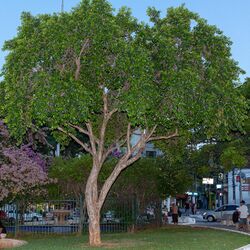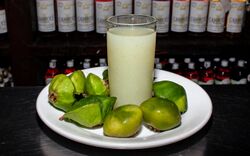Biology:Campomanesia phaea
| Campomanesia phaea | |
|---|---|

| |
| Campomanesia phaea | |
| Scientific classification | |
| Kingdom: | Plantae |
| Clade: | Tracheophytes |
| Clade: | Angiosperms |
| Clade: | Eudicots |
| Clade: | Rosids |
| Order: | Myrtales |
| Family: | Myrtaceae |
| Genus: | Campomanesia |
| Species: | C. phaea
|
| Binomial name | |
| Campomanesia phaea (Berg) Landrum
| |
| Synonyms[2] | |
| |
Campomanesia phaea is a species of plant in the family Myrtaceae. The plant is endemic to the Atlantic Forest ecoregion in southeastern Brazil . It is found in the states of Paraná, Rio de Janeiro, São Paulo.[3]
In Brazil its fruit is called cambuci and the tree cambucizeiro. Not to be confused with cambucá.
Description
Campomanesia phaea is a semi-deciduous tree with peeling bark, that grows to between 4 and 9 metres tall. It produces dark green, saucer shaped fruits around 70mm in diameter.[4]
This species has a low propagation rate, and efforts have been made to propagate it in vitro.[5]
Etymology
The name 'cambuci' comes from the Tupi-Guarani word for clay pot, because of the resemblance between the fruit and Tupi-Guarani earthenware.[6]
Uses
Campomanesia phaea is often cultivated in domestic gardens and orchards, for ornamental and culinary purposes. It is rare in the wild.[4]
The cambuci fruit has an acidic, astringent flavour. It can either be eaten either raw or prepared into jellies, sherbets, or juices.[7] The fruit is rich in vitamins and minerals and is also a source of phenolic compounds.[8]
References
- ↑ World Conservation Monitoring Centre (1998). "Campomanesia phaea". IUCN Red List of Threatened Species 1998: e.T35332A9927420. doi:10.2305/IUCN.UK.1998.RLTS.T35332A9927420.en. https://www.iucnredlist.org/species/35332/9927420. Retrieved 15 November 2021.
- ↑ "Campomanesia phaea (O.Berg) Landrum". http://www.theplantlist.org/tpl1.1/record/kew-131803.
- ↑ "Campomanesia phaea (O.Berg) Landrum". Plants of the World Online. Kew Science. http://powo.science.kew.org/taxon/urn:lsid:ipni.org:names:913775-1.
- ↑ 4.0 4.1 "Campomanesia phaea (O.Berg) Landrum". http://tropical.theferns.info/viewtropical.php?id=Campomanesia+phaea.
- ↑ Aparecido Demétrio, Christian; Fernanda de Oliveira Jacob, Jessica; Bovi Ambrosano, Guilherme; Tiago de Oliveira, Ênio; Hercílio Viegas Rodrigues, Paulo (January 7, 2021). "In vitro propagation of cambuci (Campomanesia phaea): An endangered exotic fruit and ornamental plant from Brazilian Atlantic Forest". Plant Cell, Tissue and Organ Culture 145: 203–208. doi:10.1007/s11240-020-02002-1. https://link.springer.com/article/10.1007/s11240-020-02002-1.
- ↑ María Lúcia Kawasaki; Leslie Landrum; Leslie Landrum (1997). "A rare and potentially economic fruit of Brazil: Cambuci, Campomanesia phaea (Myrtaceae)". Economic Botany 51 (4): 403–405. doi:10.1007/BF02861053. https://www.researchgate.net/publication/225169892.
- ↑ "Campomanesia phaea". http://www.b4fn.org/resources/species-database/detail/campomanesia-phaea/.
- ↑ Tatiane de O.Tokairin; Horst Bremer Neto; Angelo P.Jacomino (2018). "Cambuci—Campomanesia phaea (O. Berg.) Landrum". Exotic Fruits Reference Guide. Academic Press. pp. 91–95. doi:10.1016/B978-0-12-803138-4.00013-7. ISBN 9780128031384. https://www.sciencedirect.com/science/article/pii/B9780128031384000137.
Wikidata ☰ Q5028502 entry
 |




